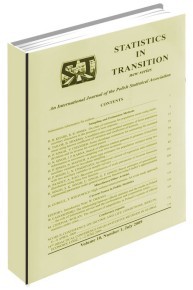Lag Length Specification in Engle-Granger Cointegration Test: A Modified Koyck Mean Lag Approach Based on Partial Correlation
Lag Length Specification in Engle-Granger Cointegration Test: A Modified Koyck Mean Lag Approach Based on Partial Correlation
Author(s): Oluokun Kasali Agunloye, D. K. Shangodoyin, Raghunath ArnabSubject(s): Economy
Published by: Główny Urząd Statystyczny
Keywords: modified Koyck mean lag;partial correlation criterion;Engle-Granger cointegration test;optimal truncation lag;information criteria;augmented Dickey-Fuller test
Summary/Abstract: The Engle-Granger cointegration test is highly sensitive to the choice of lag length and the poor performance of conventional lag selection criteria such as standard information criteria in selecting appropriate optimal lag length for the implementation of the Engle-Granger cointegration test is well-established in the statistical literature. Testing for cointegration within the framework of the residual-based Engle-Granger cointegration methodology is the same as testing for the stationarity of the residual series via the augmented Dickey-Fuller test which is well known to be sensitive to the choice of lag length. Given an array of candidate optimal lag lengths that may be suggested by different standard information criteria, the applied researchers are faced with the problem of deciding the best optimal lag among the candidate optimal lag lengths suggested by different standard information criteria, which are often either underestimated or overestimated. In an attempt to address this well-known major pitfall of standard information criteria, this paper introduces a new lag selection criterion called a modified Koyck mean lag approach based on partial correlation criterion for the selection of optimal lag length for the residual-based Engle-Granger cointegration test. Based on empirical findings, it was observed that in some instances over-specification of lag length can bias the Engle-Granger cointegration test towards the rejection of a true cointegration relationship and non-rejection of a spurious cointegration relationship. Using real-life data, we present an empirical illustration which demonstrates that our proposed criterion outperformed the standard information criteria in selecting appropriate optimal truncation lag for the implementation of the Engle-Granger cointegration test using both augmented Dickey-Fuller and generalized least squares Dickey-Fuller tests.
Journal: Statistics in Transition. New Series
- Issue Year: 15/2014
- Issue No: 4
- Page Range: 559-572
- Page Count: 14
- Language: English

